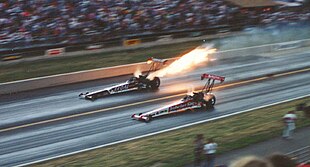
Back Versnelling Afrikaans Beschleunigung ALS ፍጥንጥነት Amharic Aceleración AN त्वरण ANP تسارع Arabic تسريع ARZ ত্বৰণ Assamese Aceleración AST Təcil Azerbaijani
| Acceleration | |
|---|---|
 In vacuum (no air resistance), objects attracted by Earth gain speed at a steady rate. | |
Common symbols | a |
| SI unit | m/s2, m·s−2, m s−2 |
Derivations from other quantities | |
| Dimension | |
| Part of a series on |
| Classical mechanics |
|---|

In mechanics, acceleration is the rate of change of the velocity of an object with respect to time. Acceleration is one of several components of kinematics, the study of motion. Accelerations are vector quantities (in that they have magnitude and direction).[1][2] The orientation of an object's acceleration is given by the orientation of the net force acting on that object. The magnitude of an object's acceleration, as described by Newton's Second Law,[3] is the combined effect of two causes:
- the net balance of all external forces acting onto that object — magnitude is directly proportional to this net resulting force;
- that object's mass, depending on the materials out of which it is made — magnitude is inversely proportional to the object's mass.
The SI unit for acceleration is metre per second squared (m⋅s−2, ).
For example, when a vehicle starts from a standstill (zero velocity, in an inertial frame of reference) and travels in a straight line at increasing speeds, it is accelerating in the direction of travel. If the vehicle turns, an acceleration occurs toward the new direction and changes its motion vector. The acceleration of the vehicle in its current direction of motion is called a linear (or tangential during circular motions) acceleration, the reaction to which the passengers on board experience as a force pushing them back into their seats. When changing direction, the effecting acceleration is called radial (or centripetal during circular motions) acceleration, the reaction to which the passengers experience as a centrifugal force. If the speed of the vehicle decreases, this is an acceleration in the opposite direction of the velocity vector (mathematically a negative, if the movement is unidimensional and the velocity is positive), sometimes called deceleration[4][5] or retardation, and passengers experience the reaction to deceleration as an inertial force pushing them forward. Such negative accelerations are often achieved by retrorocket burning in spacecraft.[6] Both acceleration and deceleration are treated the same, as they are both changes in velocity. Each of these accelerations (tangential, radial, deceleration) is felt by passengers until their relative (differential) velocity are neutralised in reference to the acceleration due to change in speed.
- ^ Bondi, Hermann (1980). Relativity and Common Sense. Courier Dover Publications. pp. 3. ISBN 978-0-486-24021-3.
- ^ Lehrman, Robert L. (1998). Physics the Easy Way. Barron's Educational Series. pp. 27. ISBN 978-0-7641-0236-3.
- ^ Crew, Henry (2008). The Principles of Mechanics. BiblioBazaar, LLC. p. 43. ISBN 978-0-559-36871-4.
- ^ P. Smith; R. C. Smith (1991). Mechanics (2nd, illustrated, reprinted ed.). John Wiley & Sons. p. 39. ISBN 978-0-471-92737-2. Extract of page 39
- ^ John D. Cutnell; Kenneth W. Johnson (2014). Physics, Volume One: Chapters 1-17, Volume 1 (1st0, illustrated ed.). John Wiley & Sons. p. 36. ISBN 978-1-118-83688-0. Extract of page 36
- ^ Raymond A. Serway; Chris Vuille; Jerry S. Faughn (2008). College Physics, Volume 10. Cengage. p. 32. ISBN 9780495386933.



